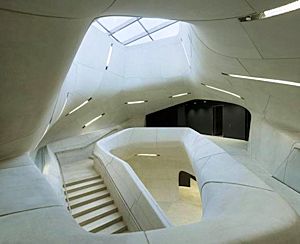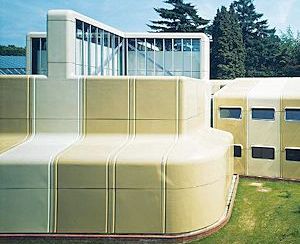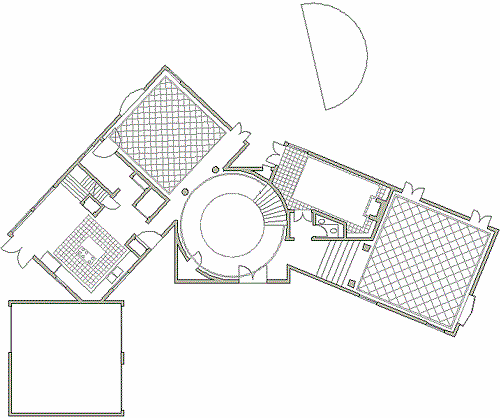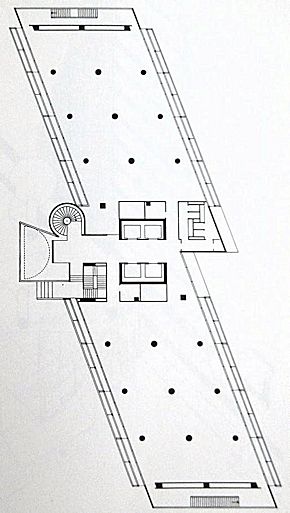2014.09.23 08:45
What do you think of the 2014 Serpentine Pavilion in London?
After reading the above comments, I was reminded of something from 2000.04.06: "So what then is architecture? Is it a hard, 'simple', 'natural' protective shell that engenders the continuation of life? Or is it a soft formlessness forever (re-)designing an applied shell it doesn't naturally have?"
As a temporary pavilion, and indeed one whose purpose is to exhibit (and somewhat test) architectural ideas, it certainly does its job well, and for that I like it. Does it portend a future mainstream trend in building? Probably not, but one really never knows for sure.
Further, I'm now reminded of (the interior of) the small (river?) museum in Louisiana from a few years ago, and also James Stirling's training building for Olivetti with its fiberglas shell.
 
2015.03.22 18:25
Pondering the cultural value of Frank Gehry's Winton Guest House
I suspect the Morandi connection is more of a mask. The clear precedents for what Gehry did with the Guest House are Kahn's Dominican Motherhouse for the Sisters of St. Catherine de Ricci (1965-68) and Stirling and Wilford's Berlin Science Center (1979). Even my own Cooper & Pratt House (1982) may predate (or was being designed at exactly the same time as) the Winton Guest House (1982-87).

| |
2015.03.22 20:44
Pondering the cultural value of Frank Gehry's Winton Guest House
Not just in plan. Kahn's, Stirling/Wilford's and Venturi/Rauch's designs are also studied volumes. The verticality of Kahn's design in particular precurses Gehry's. And I certainly don't buy that Gehry was somehow uninterested in or unaware of what other architecture was being designed and built at the time or just prior--let's just be realistic about that.
The Cooper & Pratt House was never built. It was for an in-office competition for a spec house. The 'developer'/judge picked a design that looked just like a farmhouse. Within a half year the designer of the 'farmhouse' was fired, and his design was eventually handed over to me. After a day of looking over the design, I had to ask my boss, Roger Pratt, for 10 minutes of his time so I could show him what I found, which were a myriad of functional and programmatic errors and mis-designs. Roger agreed and said, "Well, just fix it." A couple days later I showed Roger what I had done, which turned out to be a pretty decent redesign, and he took his time looking over the drawings with this odd look on his face, and then he looked directly in my face and asked, "How did you do that?"
2015.04.20 13:23
New Whitney Museum; What Do You Think?
The Engineering Building for Leicester University is by Stirling and Gowan. Stirling and Gowan parted ways, non-amicably, after the Leicester building and at the beginning of the History Faculty for Cambridge University. It is interesting to compare Gowan's and Stirling's design sketches/drawings of Leicester and see that Gowan might well deserve more credit for the design than Stirling.
2015.06.08 10:50
New photos of E. Fay Jones' Thorncrown Chapel unveiled to mark 35th anniversary
I wish I could find that Scott Brown quote from a year or two ago where she says Venturi is no longer interested in architecture. Perhaps it was only me, but the way it was phrased conjured up scenes from Whatever Happened to Baby Jane?.
Coincidentally, James Stirling died 25 June 1992.
2018.03.09 13:41
guess the plan [building]

After Le Corbusier, and even after Leon Krier, but, in all three cases, never built.
| |
2018.03.16 18:39
guess the plan [building]
Le Corbusier-Berlin . . . Krier-modern junktown anywhere . . . this plan somewhere in Spain . . . . . . . . although this plan comes after Le Corbusier and Krier, the architect actually fits nicely between Le Corbusier and Krier
2018.03.17 14:51
guess the plan [building]
The project is more extensively published within: Architectural Monographs No 32: James Stirling + Michael Wilford and within James Stirling and Michael Wilford 1975-1992 (the white book). All the drawings are now within the Stirling collection of the CCA but images of the drawings are as yet not available on the CCA website.
2018.03.17 15:06
guess the plan [building]
The project is from 1988 (just 4 years before Sirling died). If you're familiar with the late work of Stirling/Wilford and familiar with Wilford's individual works, then you can more plainly see the aspect of the Seville tower(s) plan which you attribute as 'pre-postmodern' is actually an instance of more Wilford than Stirling.
| |
|